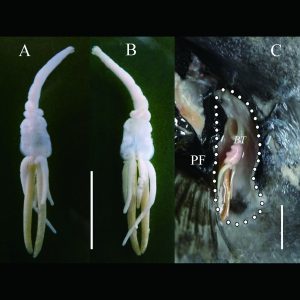Abstract / Introduction / Summary:

The lernaeopodid copepod Brachiella thynni Cuvier, 1830 is reported based on two ovigerous females from a wahoo, Acanthocybium solandri (Cuvier, 1832), caught in the western North Pacific Ocean near the southern Izu Islands off central Japan. This represents the third record of B. thynni infecting wahoo from off Japan. The females of B. thynni were each attached by their maxillae and bulla to the anterior wall of small pockets present in the axil of the pectoral fins, and their body fitted in each pocket. The female of the species is considered to be protected in the pocket from exposure to strong water flow because this copepod usually infects highly migratory scombrids, such as fast-swimming tunas (Thunnus spp.), and their pectoral fins can cover the pockets during rapid swimming.
